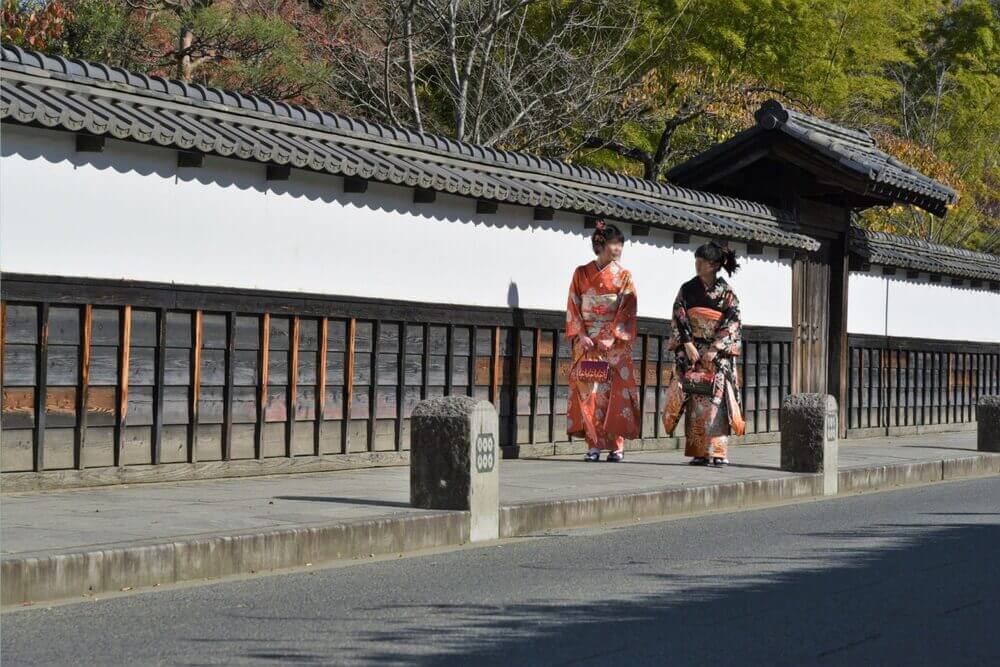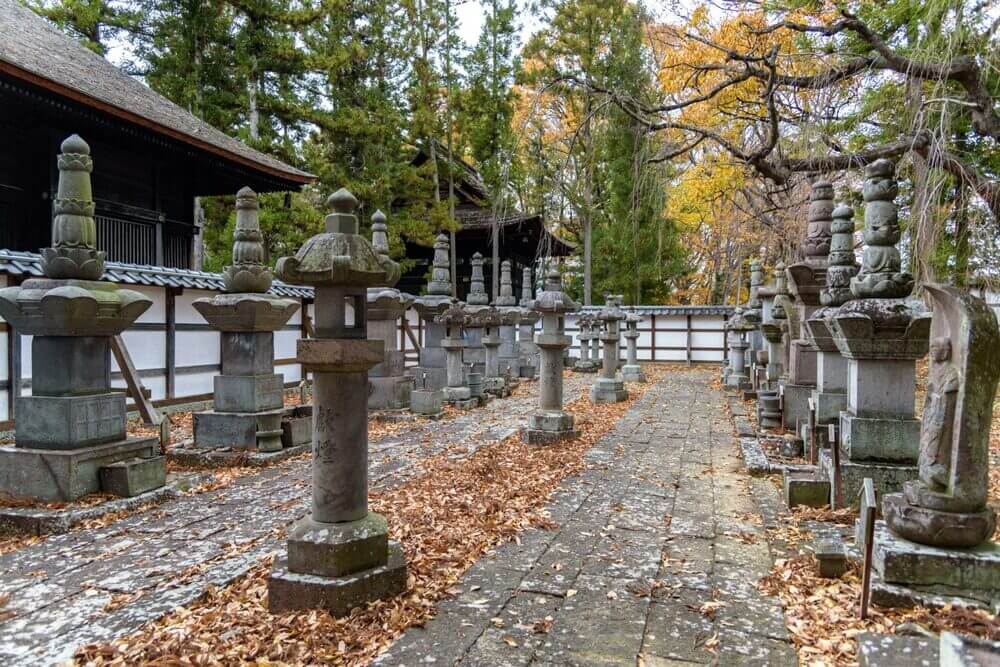Summary
Samurai – Japanese warriors who were skilled in military strategy and swordsmanship. They were known for their mastery of the sword, their fearlessness in battle and their code of honor called “bushido” which dictated their way of life. Although everyone in the world has probably heard of them, many may not be able to imagine what a samurai’s house is like.
Have you always wanted to see how samurai lived and learn more about them? Then there is no better place to visit than the historic castle town of Matsushiro! Discover what the lives of samurai were like and delve into the history of the famous samurai clan that ruled Matsushiro during the Edo Period: the Sanada clan.

To get to Matsushiro, take the bus from Nagano Station and get off at the Matsushiro Station bus stop (more info at the end of the blog). Matsushiro is a rather compact town, so you can walk around and visit the historic spots mentioned in this blog on foot if you’d like or get a rental bicycle from the Tourist Information Center which you’ll find if you follow the road down south past the former Matsushiro Station. You can also pick up a map of the area here if you haven’t got one yet. Go a little further from there and you’ll come across the first important remnant of a time when samurai roamed Japan.
Matsushiro Castle Ruins
Originally called Kaizu Castle, Matsushiro Castle was built under orders of the powerful warlord Shingen Takeda in 1560 to strategically fight against his rival Kenshin Uesugi for control of the northern region of Nagano. Although it was built on a flatland, its location near the Chikuma River and the surrounding mountains gave the castle a geographical advantage. Still, the Takeda clan eventually lost the castle to other feudal lords before it came under control of one samurai family that would leave a permanent mark on the town of Matsushiro. This was the Sanada clan.
For those of you who are familiar with Japanese history, you may have heard of the Sengoku Period (or warring states period), when Japan was divided, and many lords raged war against each other in order to take control of the land. The Sanada clan rose to prominence during the Sengoku period as a vassal of the Takeda clan and later of the Toyotomi regime. While they might not have been the most powerful samurai clan at the time, but their strategic talents and survival skills made the Sanada clan known throughout the lands.
In 1622, they relocated from Ueda to Matsushiro to become the new feudal lords of the Matsushiro Domain and took over the castle which they renamed Matsushiro Castle. They ruled for 10 generations, until the domain system was abolished.
The castle played an important part in Japanese history and as such was designated as a National Historic Site in 1981. It is also listed as one of Japan’s Top 100 Castles by the Japan Castle Foundation. Over the years, however, Matsushiro Castle itself was destroyed multiple times, so the structures that you see today are faithful reconstructions.
A visit to the castle in spring when the cherry blossoms are in bloom is highly recommended, as the area around the castle walls and the inner courtyard will be colored pink due to the cherry blossoms planted there.
Sanada Festival
As a tribute to the samurai clan who ruled Matsushiro for about 250 years, an annual festival is held around mid-October called the Sanada Juumangoku Matsuri in the form of a parade with people dressed up as samurai, princesses, foot soldiers, ninja and other historical characters. Being at the festival feels like you’re actually witnessing the procession of a great feudal lord in the Edo period.
Starting from Matsushiro Castle and making their way through the old town of Matsushiro, Lord Sanada rides on his horse as others such as flagbearers holding the flag with the Sanada family crest (the “rokumonsen”) follow him. If you’re in Nagano Prefecture around this time, you should definitely take some time to go visit Matsushiro and see it in real life.
Former Sanada Family Residence
After the castle, make your way straight down to the historic town center. Here you’ll notice what makes Matsushiro so special. The narrow streets, white plaster walls and many Edo-style houses that you’ll find scattered around make you feel like you’ve gone a couple of hundred years back into the past.
The rustic atmosphere of old Japan is extremely well-preserved, especially due to the lack of tall buildings and modernized structures. Because of its many historical buildings and its unique ambiance, Matsushiro has acted as a stage for several film productions. Of these historical buildings, the former Sanada family residence is arguably the most famous.

The residence was built by the 9th Sanada lord for his mother-in-law. Later, he used it for himself after his retirement. The Sanada family kept the residence until 1966, when they donated it to Nagano City. Along with the castle, this former Sanada residence was also designated as a National Historic Site in 1981.
It seems like no expenses were spared when building the Sanada residence. It has no less than 53 rooms (!) and many of those are decorated with elegant wallpaper that show off the family’s wealth.
Sliding open the shoji screens reveals a wooden walkway and a beautiful view.
Outside of the house, there is an impressive garden that even has a small shrine in it. You can imagine how great it would be to live here just by looking over this beautiful garden or taking a relaxing walk through it.
Admission Price: Adults 200 JPY, Elementary/Middle School Students 80 JPY
Opening Hours: 9:00~17:00 (last entry at 16:30) *Generally opened year-round
TIP! While visiting the sightseeing spots in Matsushiro, you may come across these metal signs with a QR code on it that will redirect you to an audio guide. The guide is available in 5 languages: English, Chinese, Korean, Thai and Japanese. Definitely check it out to get a better understanding of the sites.
Sanada Treasures Museum
Located close to the Sanada residence is another building that packs a lot of history. With over 50,000 items including such things as full suits of armor, paintings and old documents written by warlords that have been collected and handed down by members of the Sanada family throughout the years, the museum is indeed a treasure trove of authentic items from the age of samurai. All items are beautifully displayed behind glass panes so you can get a close-up look. The displays in the exhibition rooms are rotated four times a year.
Before the exit, you’ll pass through a room called the “Waku Waku Room” and it features a stage and several replicas of samurai armor and kimono that you can freely try on. If you want to feel like a true samurai, don’t miss this change to take a commemorative photo here!
Admission Price: Adults 300 JPY, Elementary/Middle School Students 120 JPY
Opening Hours: 9:00~17:00 (last entry at 16:30) *Closed on Tuesdays (open on national holidays) and closed for cleaning around the end of June every year.
The Chokokuji Temple
The last stop on this list that relates to the samurai lords of the Sanada clan is the Chokokuji Temple. This is the Sanada’s family temple and as such the roof of the temple is decorated with their family crest, the rokumonsen. The rokumonsen crest is named after its design, the six (roku) mon (old currency unit) coins (sen), which were said to be needed to cross the river of death in the underworld in Buddhist teachings. The message behind the crest was that the Sanada clan was not afraid of death and prepared to die in battle.
When they did die, however, their bodies were buried in the special family graveyard behind the Chokokuji Temple. There are also two mausoleums next to it, but the area is surrounded by a large wooden fence. To enter the area, ask one of the people at the temple (there is a small office on the right of the temple entrance) if you could do so. If possible, someone will open the gate with a key and show you around (admission is 300 JPY).
The two mausoleums are of the first (on the left) and the fourth (on the right) feudal lord of the Sanada clan. The mausoleum of the first feudal lord named Nobuyuki Sanada is designated as an Important Cultural Asset. For an extra fee, you can take a look inside.
To the right of the mausoleums, you will find the Sanada family grave where the lords of the Matsushiro domain are buried.
Admission Price: No charge for the precinct (around the temple)
Admission to The Mausoleums and Graveyard: Adults 300 JPY, Elementary/Middle School Students 200 JPY
Special Admission to the Mausoleum: 500 JPY
Opening Hours: 9:00~16:00 *Closed on Wednesdays and during the New Year’s Holidays
Despite the Sanada family being the most important samurai clan in Matsushiro, there are many other samurai residences found all over town, as well as other (historic) places that are waiting to be discovered. For example, did you know that part of Matsushiro was intended as a strategic stronghold during the Second World War?
With all the things it has to offer, Matsushiro is a must-visit for the Japanese culture and history buff, and highly recommended to anyone who wants to know more about samurai and others who lived during the olden times in Japan.
How to Get to Matsushiro
Matsushiro is only about half an hour away from Nagano City by bus. To get to Matsushiro, catch bus number 30 from bus stop no. 3 near the Nagano Station Zenkoji Exit. Get off at the Matsushiro Station (Matsushiro Eki) bus stop.
See timetable for Nagano station – Matsushiro >
Nagano City itself is easily reachable via train or bus. Check out the bus timetable of your desired route below.
- Bus from Ikebukuro to Nagano
- Bus from Shinjuku to Nagano
- Bus from Nagoya to Nagano
- Bus from Osaka/Kyoto to Nagano
- Bus from Narita Airport/Tokyo Disney Resort® to Nagano
- Bus from Hakuba to Nagano
- Bus from Matsumoto to Nagano
Discounted Ticket
Planning to see Nagano City and Matsushiro in one day? Then the Zenkoji & Matsushiro 1 Day Pass is perfect for you! This ticket gives you unlimited rides on various buses in the area of Zenkoji, Nagano Station and Matsushiro. You can use it on the full course of buses no. 30 and 48, as well as on buses no. 10, 11, 16, 17 and 21 between Nagano and Zenkoji and between Nagano and the Mizuno Art Museum.
Ticket Price: Adults 1,500 JPY, Children 750 JPY
Available at: ALPICO Kotsu Nagano Sta. Information Center (See map)


























